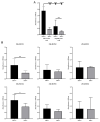Identification of Zika Virus NS1-Derived Peptides with Potential Applications in Serological Tests
- PMID: 36992364
- PMCID: PMC10052002
- DOI: 10.3390/v15030654
Identification of Zika Virus NS1-Derived Peptides with Potential Applications in Serological Tests
Abstract
Zika virus (ZIKV), a mosquito-borne pathogen, is an emerging arbovirus associated with sporadic symptomatic cases of great medical concern, particularly among pregnant women and newborns affected with neurological disorders. Serological diagnosis of ZIKV infection is still an unmet challenge due to the co-circulation of the dengue virus, which shares extensive sequence conservation of structural proteins leading to the generation of cross-reactive antibodies. In this study, we aimed to obtain tools for the development of improved serological tests for the detection of ZIKV infection. Polyclonal sera (pAb) and a monoclonal antibody (mAb 2F2) against a recombinant form of the ZIKV nonstructural protein 1 (NS1) allowed the identification of linear peptide epitopes of the NS1 protein. Based on these findings, six chemically synthesized peptides were tested both in dot blot and ELISA assays using convalescent sera collected from ZIKV-infected patients. Two of these peptides specifically detected the presence of ZIKV antibodies and proved to be candidates for the detection of ZIKV-infected subjects. The availability of these tools opens perspectives for the development of NS1-based serological tests with enhanced sensitivity regarding other flaviviruses.
Keywords: NS1 protein; Zika virus; diagnosis; epitopes; immunoassays; monoclonal antibody; peptides.
Conflict of interest statement
The authors declare no conflict of interest.
Figures






References
-
- Cardona-Ospina J.A., Trujillo A.M., Jiménez-Posada E.V., Sepúlveda-Arias J.C., Tabares-Villa F.A., Altieri-Rivera J.S., Monsalve A., Restrepo-Chica J., Osorio D., Espinoza D., et al. Susceptibility to endemic Aedes-borne viruses among pregnant women in Risaralda, Colombia. Int. J. Infect. Dis. 2022;122:832–840. doi: 10.1016/j.ijid.2022.07.017. - DOI - PubMed
Publication types
MeSH terms
Substances
LinkOut - more resources
Full Text Sources
Medical
Research Materials

